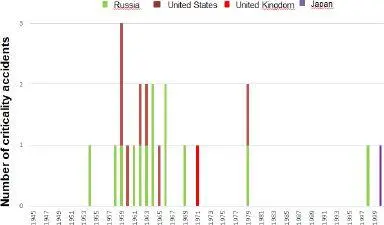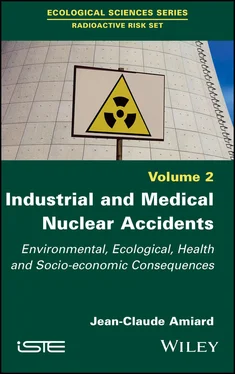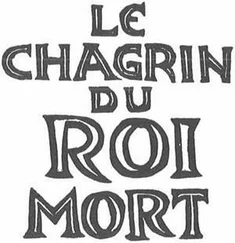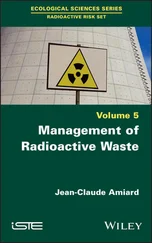|
Events (unforeseen, unexpected) |
Causes |
Consequences (CTCAE V3.0 grade) |
| 5–7 Accidents |
Death |
Dose (or volume irradiated) much higher than normal resulting in complications or outcomes not compatible with life |
|
| 4 Accidents |
A serious life-threatening event, complication or disabling condition |
Dose or volume irradiated much higher than tolerable doses or volumes |
Severe, unexpected or unpredictable acute or late reaction, grade 4 |
| 3 Incidents |
An event causing severe alteration of one or more organs or functions |
Dose or irradiated volume greater than tolerable doses or volumes |
Severe, unexpected or unpredictable acute or late reaction, grade 3 |
| 2 Incidents |
An event that causes or is likely to cause moderate impairment of an organ or function |
Dose higher than recommended doses or irradiation of a volume that may result in unexpected, moderate complications |
Moderate, unexpected or unpredictable acute or late effect, grade 2, minimal or no change in quality of life |
| 1 Event |
Event with the dosimetric consequence but no expected clinical consequence |
Dose or volume error: for example, dose error or target error during a session that cannot be compensated for over the entire treatment |
No symptoms expected |
| O event |
Event without any consequences for the patient |
For example, error in identifying a patient treated for the same pathology (compensable) |
|
Table 1.3. Procedure for the classification of an event on the basis of exposures or health consequences related to doses received [ASN 08b, IAE 13]
| Event |
Number of individuals and final ranking |
|
Minimum ranking |
Number of individuals |
Final ranking * |
| Death or lethal dose received |
|
> 10 |
6 |
| 4 |
> 1 |
5 |
|
1 |
4 |
| Deterministic effect or potential deterministic effect with respect to the dose received |
|
> 10 |
5 |
| 3 |
> 1 |
4 |
|
1 |
3 |
| Exposure greater than 1 Sv or 1 Gy |
|
> 100 |
6 |
| 4 |
> 10 |
5 |
|
≤ 10 |
4 |
| Exposure greater than 100 mSv |
|
> 100 |
5 |
| 4 |
> 10 |
4 |
|
≤ 10 |
3 |
| Exposure of worker(s) to a dose above the annual regulatory limit or of a member of the public to a dose above 10 mSv |
|
> 100 |
4 |
| 2 |
> 10 |
3 |
|
≤ 10 |
2 |
| Exposure of worker(s) to a dose above the annual regulatory limit or of a member of the public to a dose above 10 mSv |
|
> 100 |
3 |
| 1 ** |
> 10 |
2 |
|
≤ 10 |
1 |
*The highest ranking should be selected. **When a dose limit is exceeded as a result of the accumulation of exposure over a certain period of time, the ASN systematically assigns a level 1 classification for lack of a safety culture.
1.4. The typology of accidents
Nuclear accidents can be of many different types. Criticality accidents that emit large quantities of neutrons and ionizing radiation are often lethal to workers. Industrial accidents due to fire, lightning, earthquakes, tsunamis and so on can damage any protective measures leading to leaks of radioactive materials. However, radiological protection is rarely broken leading to level 4 accidents. The occurrence of a level 5 accident requires an additional supply of energy. This has already occurred in the case of a core meltdown or could occur during an external attack such as a plane crash or a hollow charge shot (ammunition allowing the armor to be pierced).
1.4.1. Criticality accidents
We have seen that criticality accidents (resulting from an unintended chain reaction) were frequent in the military arena between 1945 and 1970 [AMI 19]. This type of accident has also occurred during the manufacture of nuclear fuel for nuclear power reactors, in the latter themselves, and in industrial and medical applications of nuclear technology (linear accelerators, radiotherapy). Accidents can occur in aqueous fissile media, in solid or dry metal media, and in mixed solid/liquid media. On the contrary, no cases have been reported for “powder” media.
Most accidents occurred in the United States (Hanford, Idaho Falls, Los Alamos, Oak Ridge and Wood River Junction) and in the former USSR (Obninsk, Electrostal, Mayak, Tomsk and Novosibirsk) [MCL 00] (Figure 1.1).
Since 1945, 60 criticality accidents, only six of which occurred after 1978, have occurred worldwide, mainly in research reactors and in laboratories. This means that until the early 1980s, there was more than one accident per year. The last three accidents occurred in Tokai-Mura, Japan (two in 1997 and one in 1999).
In a significant number of cases, these accidents resulted in immediate deaths or severe radiation exposure leading to premature death. Criticality accidents resulted in 17 deaths [GAM 07], 19 deaths [IRS 09a] or 20 deaths [MCL 00] depending on the sources. The procedure to be followed in the event of a criticality accident has been detailed by Miele and Lebaron-Jacobs [MIE 05].

Figure 1.1. Chronology of the main criticality accidents (adapted from [MCL 00]). For a color version of the figure, see www.iste.co.uk/amiard/industrial.zip
1.4.2. Accidents in nuclear power reactors
Experimental nuclear reactors or power generators have been the subject of several accidents. The two largest nuclear disasters concern four nuclear power reactors (Chernobyl-4, Fukushima Daiichi-1, 2 and 3). All nuclear facilities were affected by a severe accident of levels 4–7. The economic consequences can be enormous.
1.4.3. Losses of radioactive sources
Highly radioactive sources are used for industrial purposes (non-destructive testing, food irradiation, etc.) or medical purposes (radiotherapy, brachytherapy). When these sources are lost, they can be found by the public. Since they are discrete (usually a small plastic cylinder), they can radiate strongly and for a long time, affecting any person in contact with this source, as well as their professional or family entourage. The number of accidents of this type is high, and the number of fatal cases is also relatively high. Among the most serious accidents of this type were those in Mexico City (Mexico) in 1962, Chiba (Japan) in 1971, Algeria in 1978, Brazil in Goiânia in 1987, Istanbul (Turkey) in 1999, Grozny (Russia) in 1999 and Samut Prakan (Thailand) in 2000. Each time several deaths were reported.
1.4.4. Radiotherapy accidents
Many types of cancers are treated by radiotherapy. The irradiation dose must be carefully calculated to kill all cancer cells. If underexposed, the patient has not been treated adequately and is at risk of dying from cancer. In the event of overexposure, healthy cells are irradiated and the risk of secondary cancer is not negligible. These cases of under- or over-exposure are most often a result of human error, either through the misuse of irradiation equipment (incorrect calculation of the irradiation dose, incorrect adjustment of the irradiation equipment) or through improper transmission of information.
Читать дальше













